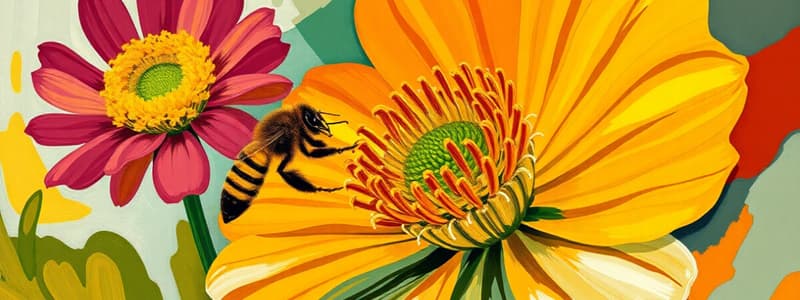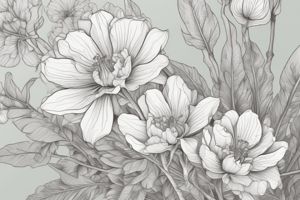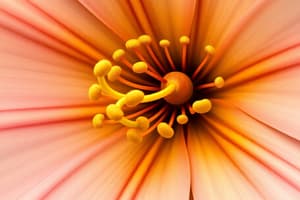Podcast
Questions and Answers
What is the function of the stigma in a flower's carpel?
What is the function of the stigma in a flower's carpel?
- To support the ovary
- To receive pollen grains (correct)
- To produce ovules
- To develop into fruit
What is formed from the fertilization of the egg in the ovule?
What is formed from the fertilization of the egg in the ovule?
- Microsorus
- Endosperm
- Pollen tube
- Zygote (correct)
Which part of the flower's carpel serves as the stalk between the stigma and the ovary?
Which part of the flower's carpel serves as the stalk between the stigma and the ovary?
- Stamen
- Ovary
- Style (correct)
- Pistil
What occurs after pollination in the fertilization process?
What occurs after pollination in the fertilization process?
What is the ploidy level of the endosperm formed after double fertilization?
What is the ploidy level of the endosperm formed after double fertilization?
What is a consequence of the development of agriculture?
What is a consequence of the development of agriculture?
Which plant-derived compound is known to treat malaria and has been used since the 1650s in Europe?
Which plant-derived compound is known to treat malaria and has been used since the 1650s in Europe?
In botany, which of the following focuses on the study of plant structure and function?
In botany, which of the following focuses on the study of plant structure and function?
What is a primary factor for the separation of humans from nature as a consequence of agriculture?
What is a primary factor for the separation of humans from nature as a consequence of agriculture?
Which of the following is NOT a result of human agricultural practices?
Which of the following is NOT a result of human agricultural practices?
What percentage of oxygen do plants contribute to the atmosphere?
What percentage of oxygen do plants contribute to the atmosphere?
What role does cellulose play in plants, particularly in cotton?
What role does cellulose play in plants, particularly in cotton?
Which of the following beverages is derived from a plant that produces caffeine?
Which of the following beverages is derived from a plant that produces caffeine?
What is the most common organic polymer on Earth?
What is the most common organic polymer on Earth?
Which of the following statements is true about thylakoids?
Which of the following statements is true about thylakoids?
What substance prevents the zygote from drying out in land plants?
What substance prevents the zygote from drying out in land plants?
Which feature is unique to the embryophyte condition?
Which feature is unique to the embryophyte condition?
What type of cell division is characterized by the formation of a cell plate?
What type of cell division is characterized by the formation of a cell plate?
What is the role of the male flower in the process of self-fertilization in hummingbirds?
What is the role of the male flower in the process of self-fertilization in hummingbirds?
What is a primary advantage of the move to land for early plants?
What is a primary advantage of the move to land for early plants?
What type of reproductive structure do land plants develop?
What type of reproductive structure do land plants develop?
What major adaptation occurred around 500 million years ago that allowed plants to colonize drier environments?
What major adaptation occurred around 500 million years ago that allowed plants to colonize drier environments?
In the alternation of generations, what is the ploidy of the zygote?
In the alternation of generations, what is the ploidy of the zygote?
What characterizes the photosynthesis process in the viridiplantae clade?
What characterizes the photosynthesis process in the viridiplantae clade?
Which of the following is the main energy storage molecule in plants?
Which of the following is the main energy storage molecule in plants?
What distinguishes the polysaccharides starch and cellulose in plants?
What distinguishes the polysaccharides starch and cellulose in plants?
When did the first plastid, marking the divergence of plants from red algae, appear?
When did the first plastid, marking the divergence of plants from red algae, appear?
Which pigment assists chlorophyll A by absorbing different wavelengths of light?
Which pigment assists chlorophyll A by absorbing different wavelengths of light?
What is the significance of the oxygen revolution in the history of life?
What is the significance of the oxygen revolution in the history of life?
What is the role of the antheridium in the alternation of generations?
What is the role of the antheridium in the alternation of generations?
What is the primary characteristic of the sporophyte generation?
What is the primary characteristic of the sporophyte generation?
Which of the following best describes a spore?
Which of the following best describes a spore?
Which of the following is NOT a major division of land plants?
Which of the following is NOT a major division of land plants?
What is a key feature of the life cycle of mosses?
What is a key feature of the life cycle of mosses?
In the context of plant life cycles, what distinguishes gametophytes?
In the context of plant life cycles, what distinguishes gametophytes?
How do spores differ from gametes?
How do spores differ from gametes?
What process do haploid spores undergo to eventually form a gametophyte?
What process do haploid spores undergo to eventually form a gametophyte?
What is the primary function of root hairs in a vascular plant?
What is the primary function of root hairs in a vascular plant?
Which type of root system is characterized by a single prominent root, often referred to as a taproot?
Which type of root system is characterized by a single prominent root, often referred to as a taproot?
What is the main role of the stem in vascular plants?
What is the main role of the stem in vascular plants?
Which of the following best describes the function of phloem in vascular tissue?
Which of the following best describes the function of phloem in vascular tissue?
What distinguishes monocots from dicots in terms of cotyledons?
What distinguishes monocots from dicots in terms of cotyledons?
Which part of the leaf is primarily responsible for photosynthesis?
Which part of the leaf is primarily responsible for photosynthesis?
What is the primary function of dermal tissue in plants?
What is the primary function of dermal tissue in plants?
Which of the following structures is involved in the gaseous exchange in plants?
Which of the following structures is involved in the gaseous exchange in plants?
Flashcards
Plant Domestication
Plant Domestication
The process by which humans selectively breed plants for desired traits, leading to changes in their genetic makeup over time.
Animal Domestication
Animal Domestication
The process by which humans selectively breed animals for desired traits, resulting in changes in their genetic makeup and behavior over time.
Consequences of Agriculture
Consequences of Agriculture
The invention of agriculture, approximately 10,000 years ago, led to significant changes in human societies, including the emergence of permanent settlements, larger populations, and specialized economic activities.
Plant Secondary Compounds
Plant Secondary Compounds
Signup and view all the flashcards
Quinine
Quinine
Signup and view all the flashcards
Caffeine
Caffeine
Signup and view all the flashcards
Botany
Botany
Signup and view all the flashcards
Plant Cell Biology
Plant Cell Biology
Signup and view all the flashcards
Cuticle
Cuticle
Signup and view all the flashcards
Sporopollenin
Sporopollenin
Signup and view all the flashcards
Cell plate and phragmoplast
Cell plate and phragmoplast
Signup and view all the flashcards
Plasmodesmata
Plasmodesmata
Signup and view all the flashcards
Cellulose
Cellulose
Signup and view all the flashcards
Gametangia
Gametangia
Signup and view all the flashcards
Embryophyte condition
Embryophyte condition
Signup and view all the flashcards
Alternation of generations
Alternation of generations
Signup and view all the flashcards
Starch
Starch
Signup and view all the flashcards
Chlorophyll B
Chlorophyll B
Signup and view all the flashcards
Primary Endosymbiosis
Primary Endosymbiosis
Signup and view all the flashcards
Viridiplantae
Viridiplantae
Signup and view all the flashcards
Colonization of Land by Plants
Colonization of Land by Plants
Signup and view all the flashcards
Vascular Tissue
Vascular Tissue
Signup and view all the flashcards
What is the function of the stigma?
What is the function of the stigma?
Signup and view all the flashcards
What is the function of the style?
What is the function of the style?
Signup and view all the flashcards
What is the function of the ovary?
What is the function of the ovary?
Signup and view all the flashcards
What is a fruit?
What is a fruit?
Signup and view all the flashcards
What happens during double fertilization in flowering plants?
What happens during double fertilization in flowering plants?
Signup and view all the flashcards
Spore
Spore
Signup and view all the flashcards
Gametophyte
Gametophyte
Signup and view all the flashcards
Sporophyte
Sporophyte
Signup and view all the flashcards
Antheridium
Antheridium
Signup and view all the flashcards
Archegonium
Archegonium
Signup and view all the flashcards
Gamete
Gamete
Signup and view all the flashcards
Fertilization (in plants)
Fertilization (in plants)
Signup and view all the flashcards
Self-pollination
Self-pollination
Signup and view all the flashcards
Cross-pollination
Cross-pollination
Signup and view all the flashcards
Self-pollination
Self-pollination
Signup and view all the flashcards
Cross-pollination
Cross-pollination
Signup and view all the flashcards
Dermal tissue
Dermal tissue
Signup and view all the flashcards
Xylem
Xylem
Signup and view all the flashcards
Phloem
Phloem
Signup and view all the flashcards
Study Notes
Lecture 1 Summary
- Agriculture involved domesticating plants and animals, as seen in Iraq with wheat.
- The invention occurred approximately 10,000 years ago in multiple locations.
- Consequences included permanent settlements, larger families, more diverse economies, and socioeconomic classes.
- Human separation from nature and larger-scale wars were also consequences.
- Examples include the chocolate plant and gasoline which is derived from plants 300 million years old, rubber (1/3 from plants), tires, clothing, and cotton, all related to plant-derived cellulose (a glucose polymer).
Drugs: Plant Secondary Compounds
- Plant secondary compounds aren't essential for growth and development, and exist in around 200,000 variations.
- Seeds come from flowers and fruits.
- Quinine, from cinchona trees (South America- now globally), treats malaria, anemia, and muscle spasms.
- Caffeine comes from coffee plants (Yemen and Ethiopia).
- Aspirin from willow species.
- Nicotine from tobacco, opium from poppies.
- Taxol, from yew trees, treats various cancers.
Hoh Rainforest
- Plants produce oxygen and energy utilized by other terrestrial ecosystems, plants make up half the oxygen, marine life makes the other half.
- Plant importance includes food production, fossil fuels, clothing, medicines, ecosystem functioning, and biodiversity.
- Botany is the study of plants, focusing on evolution, ecology (communities, populations, and genetics), modeling differing ecosystems/environments, morphology (external and internal features), and physiology.
- Cell biology examines cellular components, systems, and developmental processes relevant to plant structure and function.
Cardinal Flowers
- Plants first are male then convert to female, with upper flowers being younger and bottom flowers being the oldest.
- Self-fertilization occurs when a ruby-throated hummingbird visits a male flower (closer to top) for nectar, then transfers pollen to a female flower (closer to bottom).
- Plants are from the Viridiplantae clade, encompassing chlorophytes (green algae), charophytes, and embryophytes (land plants).
- Viridiplantae encompasses all organisms within the clade.
When do Plants appear in History?
- Earth formation occurred about 4,550 million years ago.
- Photosynthesis emerged approximately 3,500 million years ago (cyanobacteria).
- The oxygen revolution occurred roughly 2,400 million years ago.
- Multi-cellular eukaryotes, along with the first plastids, and plant and red algae divergence, occurred about 1,500 million years ago.
- Colonization of land by plants, fungi, and animals, took place about 500 million years ago.
- Plants split from red algae 1.5 billion years ago.
Features of all Plants
- Starch is a primary energy storage molecule, consisting of glucose residues (amylose and amylopectin).
- Chlorophyll b, an accessory pigment, enhances energy transfer to chlorophyll a and absorbs different wavelengths.
- Cellulose is a major structural component of plant cell walls.
- Thylakoids form stacks called grana in chloroplasts.
Features of Streptophytes (Charophytes and Land Plants)
- Charophytes are mostly green algae closely related to land plants.
- Evidence includes shared characteristics in DNA (nuclear and chloroplast) and structure.
- Streptophytes and land plants share a common ancestor, though land plants are not descended from modern charophytes.
Features of Streptophytes (Charophytes and Land Plants), continued
- Cell plate and phragmoplast: crucial plant cell division structures.
- Plasmodesmata allow cytoplasmic connection between cells in plants.
- Asexual reproduction in plants involves sperm structure, peroxisome enzymes, and rose-shaped cellulose-synthesizing complexes.
- Sporopollenin protects spores and pollen.
Moving to Land: Advantages of Being on Land
- Air filters less sunlight compared to water.
- Air holds more CO2 which serves as fuel in photosynthesis.
- Early terrestrial habitats lacked some pathogens and predators.
- Terrestrial soil is richer in nutrients than aquatic environments.
Land Plants: Features of Embryophytes
- Embryophytes live in dry environments
- Characteristics including cuticle, multicellular, and jacketed sex organs (gametangia).
- Embryophyte condition, zygote is retained in maternal tissue, leading to an embryo.
- Alternation of generations: alternating diploid (2n) and haploid (n) phases of life cycle.
- Sexual reproduction involves gametangia (antheridium & archegonium) producing haploid sperm and eggs.
Alternation of Generations
- Alternation of Haploid and diploid stages in plant life.
- Gametophytes (form gametes (haploid))
- Sporophytes (form spores (diploid))
- Spore: single cell that divides to create a multicellular organism, often with a protective coat, produced by meiosis.
- Gamete- single cell that, when fused with another, produces a diploid zygote.
- Green Algae- life as a single haploid cell, no alternation of generations.
Alternation of Generations, continued (Spores and Gametophytes, Diploid & Haploid)
- Spores produced by meiosis mature into multicellular haploid gametophytes.
- Gametophytes (haploid) release gametes.
- Fusion of gametes (fertilization) creates a diploid (2n) zygote
- The zygote develops into the diploid sporophyte.
Spores: 1 size or 2?
- Homosporous spore production produces one spore type leading to a bisexual gametophyte.
- Heterosporous spore production produces microspores and megaspores, leading to separate male and female gametophytes.
5 Divisions (Phyla) of Seed Plants
- Coniferophyta (conifers)
- Anthophyta (flowering plants-angiosperms) Seed plants have seeds and pollen.
Seed Plants: Seeds (gymnosperm)
- The embryo with food reserves protected by a seed coat.
- Seeds are produced from the ovule after fertilization, developing from a zygote, and containing an embryo and food supply.
- The seed coat arises from the integuments.
Seed Plants: Ovules (Gymnosperms)
- The ovules contain sporophyte tissue and the (haploid) megasporocyte, which produces the egg cell.
- Pollen grains make water unnecessary for fertilization, being easily dispersed by wind.
- Seeds better survive than spores.
Plant Hierarchical Organization (Roots)
- Roots anchor the plant, absorb minerals and water, and store carbohydrates.
- Lateral roots branch from the primary root, enhancing the root system's ability to anchor and absorb water and minerals.
- Tap roots are tall, erect, and developed from primary roots, with root hairs for increased surface area.
Plant Hierarchical Organization (Stems)
- Stems support and separate leaves, and expose them to sunlight.
- Nodes are points where leaves attach, and internodes are segments between nodes.
- Apical buds are in stems and shoots, and axillary buds are in the upper angles formed by leaves and stems.
Plant Hierarchical Organization (Leaves)
- Leaves are major photosynthetic organs, maximizing photosynthesis
- Stomata, pores in leaves, allow CO2 exchange
Dermal, Vascular, and Ground Tissue
- Dermal Tissue- protects the plant.
- Dermal tissue includes epidermis, guard cells, and cuticle to regulate water loss.
- Vascular Tissue- primary transport of water and nutrients (xylem and phloem)
- Ground Tissue- photosynthesis, storage, and support through various specialized cell types.
Plant Growth (Meristems)
- Meristems are plant tissues that remain embryonic, allowing for indeterminate growth.
- Primary growth involves apical meristems from tips of roots, and shoots, allowing root extension in the soil and shoot growth.
- Secondary growth, occurs in woody plants, increases stem and root diameter via vascular cambium that produces vascular tissue.
Secondary Growth
- Vascular cambium produces secondary xylem and phloem and replaces epidermis with a tougher periderm
- The cork cambium, a lateral meristem, forms additional layers of tissues.
Leaf Anatomy (stomach)
- Stomata are pores in leaves that allow CO2 exchange during photosynthesis.
Leaf Primordia
- Leaf primordia are the embryonic structures that eventually become fully-functional leaves.
Summary of Seed Plant Life Cycle
- Seeds and pollen are adaptations that allow for fertilization without water in seed plants, with reproductive structures such as cones and flowers for male and female reproductive organs.
- Gymnosperms have naked seeds while angiosperms have enclosed seeds.
Studying That Suits You
Use AI to generate personalized quizzes and flashcards to suit your learning preferences.
Related Documents
Description
Explore the intricate functions of flower carpels and the impact of agriculture on plant life and the environment. This quiz covers aspects of pollination, fertilization, and the role of plants in our ecosystem, including their contributions to oxygen production and medicinal uses. Test your knowledge of botany and its significance for human societies.




